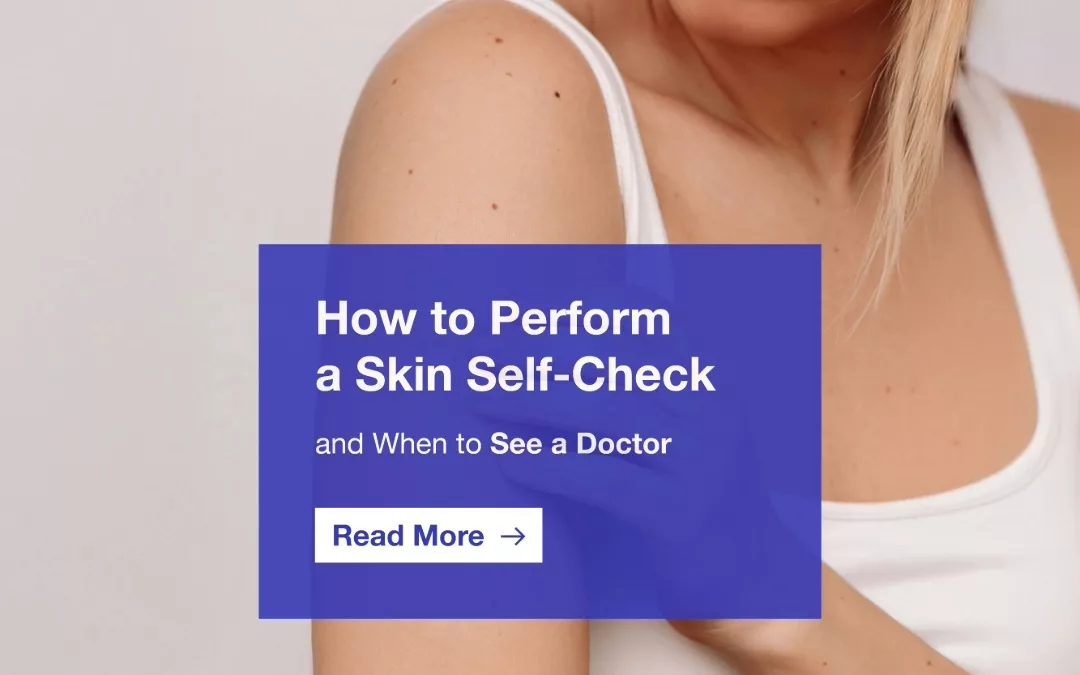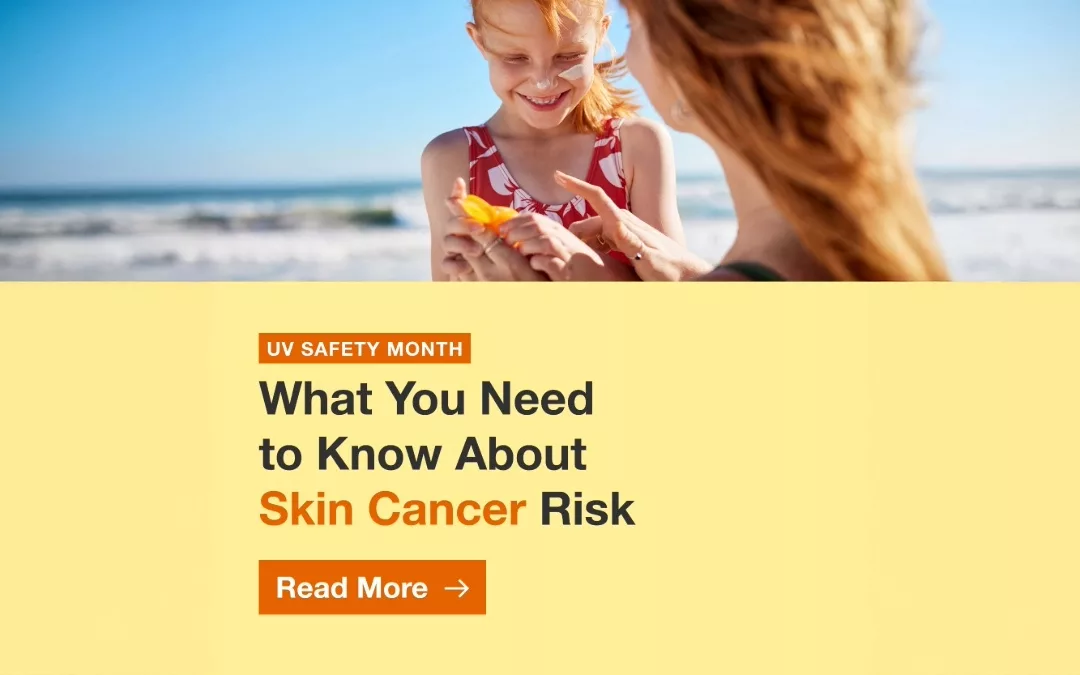
by Jessica Mason | Jul 30, 2025 | Skin Cancer
When it comes to skin cancer, early detection can make all the difference, and one of the most effective tools is a regular skin self-check. This simple at-home practice helps you become familiar with your skin so you can notice new or changing spots early, when treatment is most successful.
Whether you’re keeping an eye on an existing mole, noticing a new spot, or just being proactive, getting to know your skin, and what’s normal for you, can help catch potential problems before they become serious.
Why Skin Self-Checks Matter
Skin cancer is the most common cancer in the United States, with 1 in 5 Americans developing it by age 70. While routine visits with a physician are important, most skin cancers are found first by the person who has them.
Regular self-checks help you:
- Spot new or changing moles or spots early
- Track anything unusual between check-ups
- Know when it’s time to contact your healthcare provider
What to Look For: Use the ABCDE Rule
When you start your skin self-check, keep the ABCDEs in mind:
A = Asymmetry: one half doesn’t match the other
B = Border: edges are irregular, blurred, or notched
C = Color: varies in color, shades of brown, black, red, white, or blue
D = Diameter: larger than 6mm or about the size of a pencil eraser
E = Evolving: changes in size, shape, color, or behavior (itching, bleeding, etc.)
Also look for new growths or sores that don’t heal, spots that itch, bleed, or crust over, and any mole that feels different or stands out from the rest.
What You’ll Need and How to Do a Head-to-Toe Skin Check:
- Full length mirror
- Hand mirror
- Good lighting
- Chair or stool (optional, for checking feet or legs)
- A way to track any changes, this could be a skin map, photos, or a notes app
Follow these simple steps to examine your entire body:
- Start with your face, neck, and ears. Don’t forget behind your ears and along your hairline.
- Check your scalp. Use a comb or hairdryer to part your hair and check your scalp with a mirror or ask someone to help.
- Look at your hands and arms. Check your palms, the backs of your hands, between fingers, under fingernails, and both sides of your arms.
- Examine your torso. Look at your chest, stomach, underarms, and under your breasts if possible.
- Use a hand mirror to check your back and shoulders. You can also turn your back to a large mirror and use a hand mirror to see hard-to-reach areas.
- Check your legs and feet. Look at the fronts and backs of your legs, between your toes, the soles of your feet, and under your toenails.
How Often Should You Do a Skin Check?
Aim to check your skin once a month. It’s quick, easy, and helps you get familiar with your skin so you can notice changes more confidently over time.
When to See a Doctor
If you notice anything new, changing, or unusual, schedule an appointment with your doctor. Even if it turns out to be nothing, it’s better to be safe and catch potential issues early. You should also consider a professional skin check if:
- You have a history of sunburns or tanning bed use
- You have had skin cancer in the past
- You have many moles or a family history of skin cancer
- You notice something you’re not sure about
Skin self-checks are a simple but powerful way to protect your health. This July, and every month, take a few minutes to check in with your skin. And if something doesn’t seem right, don’t wait. Early detection can save lives.

by Jessica Mason | Jul 30, 2025 | Awareness Month, Skin Cancer
The sun is a powerful source of energy, but without protection, its ultraviolet (UV) rays, along with those from artificial sources like tanning beds, can cause lasting skin damage and significantly raise your risk of skin cancer, the most common cancer in the United States. July is recognized as UV Safety Month, a national observance that raises awareness about the dangers of UV exposure without protection and encourages habits to protect your skin every day.
While spending time outdoors has many benefits, being sun smart is essential to lifelong skin health. Understanding your risk and taking simple, consistent steps to protect your skin can make all the difference.
What Are UV Rays, Why Do They Matter, and What’s Link Between UV Exposure and Skin Cancer?
UV rays are a form of invisible radiation from the sun and from artificial sources like tanning beds that can damage your skin and eyes. There are two main types of UV rays that affect your body:
- UVA rays penetrate deep into the skin and contribute to premature aging, long-term skin damage, and sunburn. They’re present year-round, even on cloudy days, and can pass through windows.
- UVB rays are more intense and primarily responsible for sunburn. They directly damage skin cells and play a significant role in the development of skin cancer.
- In addition to harming your skin, UV rays can also damage your eyes, increasing the risk of cataracts, macular degeneration, and even cancers of the eyelids. Wearing UV-blocking sunglasses is just as important as protecting your skin.
The Link Between UV Exposure and Skin Cancer
Skin cancer affects 1 in 5 Americans by the age of 70, and UV radiation is the leading environmental cause. Here’s how it connects to the three main types:
- Basal cell carcinoma (BCC): the most common and slowest-growing form of skin cancer. It’s typically found on areas that receive frequent sun exposure, such as the face, ears, neck, scalp, shoulders, and back.
- Squamous cell carcinoma (SCC): often linked to chronic UV exposure over time. It can spread if left untreated and is most commonly found on the ears, scalp, neck, and hands—areas regularly exposed to sunlight.
- Melanoma: less common, but far more dangerous. Melanoma can spread quickly and become life-threatening if not caught early. It can appear on any part of the body, including areas not typically exposed to the sun, such as the soles of the feet or under nails. While UV exposure and sunburns increase risk, genetics and intermittent intense exposure also play a role. That’s why checking your entire body, not just sun-exposed areas, is crucial during a skin self-exam.
Who is Most at Risk?
While anyone can develop skin cancer, some factors increase your risk, including:
- Fair skin, light hair, or light eyes
- A history of frequent sunburns
- Use of tanning beds
- Family history of skin cancer
- A weakened immune system
- Spending a lot of time outdoors without sun protection
How to Protect Yourself
Practicing sun safety every day, especially in the summer, can significantly reduce your risk. Here’s how:
- Apply broad-spectrum sunscreen (SPF 30 or higher) every day, even on cloudy days
- Reapply sunscreen every two hours, or more often if swimming or sweating
- Wear protective clothing, wide-brimmed hats, and UV blocking sunglasses
- Seek shade when the sun is strongest (10 a.m. to 4 p.m.)
- Avoid tanning beds completely, they emit harmful UV rays
Protecting your skin doesn’t mean avoiding the sun altogether; it means being smart about your exposure. Incorporating habits into your routine like keeping sunscreen in your bag/car, setting reminders to reapply during long days outdoors, and encouraging loved ones to protect their skin, too can make a big difference right away.
When to See a Doctor
Early detection is key to successful skin cancer treatment. Perform regular skin self-checks and look for:
- New or changing moles or spots
- Asymmetry, irregular borders, multiple colors, or a diameter larger than a pencil eraser
- Spots that itch, bleed, or won’t heal
Use the ABCDE rule (asymmetry, border, color, diameter, evolving) to assess anything that looks suspicious. If you notice any changes, talk to your doctor.
This UV Safety Month, we encourage you to check in on your sun protection habits. Whether you are headed to the beach or running errands, daily precautions go a long way toward reducing your risk of skin cancer.
by Jessica Mason | May 12, 2025 | Skin Cancer
Skin cancer is the most common type of cancer, but the good news is that it can often be treated successfully if caught early. Knowing what to look for can make all the difference. Here are some key signs and tips to help you spot skin cancer early.
1. The ABCDE Rule for Melanoma
Melanoma is one of the most dangerous forms of skin cancer. Use the ABCDE rule to identify potential melanomas:
- Asymmetry: One half of the mole or spot doesn’t match the other half.
- Border: The edges are irregular, ragged, notched, or blurred.
- Color: The color is not uniform and may include shades of brown, black, pink, red, white, or blue.
- Diameter: The spot is larger than ¼ inch across (about the size of a pencil eraser), although melanomas can be smaller.
- Evolving: The mole is changing in size, shape, or color.
2. Basal Cell Carcinoma Signs
Basal cell carcinoma is the most common type of skin cancer. Look for:
- Flat, firm, pale, or yellow areas, similar to a scar.
- Raised reddish patches that might be itchy.
- Small, translucent, shiny, pearly bumps that are pink or red and may have blue, brown, or black areas.
- Pink growths with raised edges and a lower area in the center, which might have abnormal blood vessels spreading out like the spokes of a wheel.
- Open sores that don’t heal or heal and then come back.
3. Squamous Cell Carcinoma Signs
Squamous cell carcinoma is another common type of skin cancer. Watch for:
- Rough or scaly red patches that might crust or bleed.
- Raised growths or lumps, sometimes with a lower area in the center.
- Open sores that don’t heal or heal and then come back.
- Wart-like growths.
4. General Warning Signs
Regardless of the type, here are some general signs that could indicate skin cancer:
- Any new spots or growths on your skin.
- Any spot that looks different from others on your body.
- Sores that don’t heal.
- Redness or new swelling beyond the border of a mole.
- Itching, pain, or tenderness that doesn’t go away or comes back.
- Changes in the surface of a mole, such as oozing, scaliness, bleeding, or the appearance of a lump or bump.
Taking Action
- If you notice any of these signs, it’s important to see a healthcare provider for further evaluation.
- Regular monthly self-exams and yearly (or more frequently if you are at higher risk) full body skin exams with a dermatologist can help catch skin cancer early when it’s most treatable.
- Avoid tanning and do not use UV tanning beds.
Remember, protecting your skin from the sun by wearing broad spectrum sunscreen SPF 30 or higher, seeking shade, do not get sunburned, wear UV blocking sunglasses, and wearing protective clothing can help reduce your risk of developing skin cancer.
Stay vigilant and take care of your skin!



